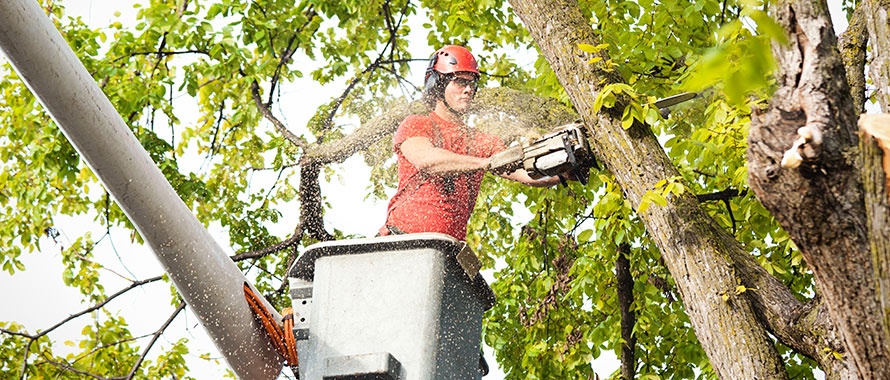A homeowner in Memphis, Tennessee, says a tree trimming company’s negligence led to the tragic death of her daughter’s dog after he was electrocuted by a powerline left unattended by the company. According to a report from WMC-TV, the dog had been let outside by the homeowners, who did not know crews from ABC Professional Tree Trimming had left a live wire in their yard after cutting down branches.
Featured Solutions
“It is a horrible situation for the dog and for the family,” said Connor Farquharson, Manager, Commercial Insurance, Burns & Wilcox, Dallas/Ft. Worth, Texas. “Leaving a wire exposed and unattended, and not even saying anything to anyone, is a huge issue. There are also a lot of other things that could have happened from that, from human fatalities to fires getting started. As bad as that situation is, it could have been even worse.”
The electrocution was the third tree-trimming incident to occur that month, WMC-TV reported, and ABC Professional Tree Trimming was expected to launch a full investigation into what happened. Lawsuits are possible after this type of incident and could be covered by a contractor’s Commercial General Liability (CGL) Insurance, said Kyle Lacertosa, Underwriter, Commercial Insurance, Burns & Wilcox, New York, New York.

Leaving a wire exposed and unattended, and not even saying anything to anyone, is a huge issue. … As bad as that situation is, it could have been even worse.
“The homeowner could sue for veterinarian bills, emotional discomfort, sleeplessness, depression from losing a companion — a lot of things could go into it,” Lacertosa said, adding that the utility company could also be brought into a lawsuit. “The insurance companies could both be pointing the finger at one another. They could be three years later fighting this in court, and the defense costs are incredibly high in these instances.”
Oversight could have escalated ‘very quickly,’ increasing costs
Tree-trimming contractors “face multiple dangers on a regular basis,” said Saad Ali, Associate Broking Commercial Manager, Burns & Wilcox, Toronto, Ontario. Tree workers in the U.S. experience some of the highest rates of fatal and nonfatal injuries compared to other industrial occupations, according to the Bureau of Labor Statistics, and logging and forestry work ranked among Canada’s most dangerous jobs in 2022. Third parties can also be harmed during tree-trimming operations, Ali said.
“This is a very sad story, but it could have been much worse,” he said. “Somebody’s child could have been hurt. Trees can fall on someone. Third-party claims happen fairly often, but there are many things that can be done to prevent such things from happening.”
In the event of a lawsuit, a company’s CGL Insurance could help pay for legal defense, settlements, and other payments related to the incident. While a lawsuit filed over an animal’s death could still come with high costs, the potential expense could escalate significantly if humans were harmed, Farquharson said. “This one is relatively small, but it could have become a much bigger issue very quickly,” he said. “It could have been much more complicated if a child or homeowner was accidentally electrocuted. Or what if another contractor came on the land for another reason, like landscaping, and got electrocuted? It is opening them up to a ton of different issues.”

Third-party claims happen fairly often [to tree contractors], but there are many things that can be done to prevent such things from happening.
In these situations, “that could be a million-dollar claim that shuts down your business right there,” Lacertosa said.
In either case, both small and large claims can be detrimental to a contractor. In addition to costs that immediately follow an accident, a company could be non-renewed by its insurance carrier after a claim or face increased rates. “Those would be the two biggest things that could happen,” Farquharson said.
It is also important to know that the frequency of claims is often a greater concern for insurance carriers than a single, more severe claim. “Contractors may think that just because it is a small claim, it is not as important. Frequency is worse than severity,” he said. “If a company has three or four claims in a year and they are all small, you know there will probably be a bad one coming — it is just a matter of time. After a big claim, most businesses will make huge changes to operations to ensure they do not have another one. If they continue to have lots of small claims, there will be more coming and eventually one of them will be big.”
Insurance policy may exclude subcontractors
Tree-trimming contractors can face legal claims over a variety of issues. Last year, the family of a teenager who was injured by a falling tree branch filed a lawsuit against the city of New Orleans, a tree service company and multiple other entities, alleging previous work and a negligent inspection contributed to the accident, WWL Louisiana reported in July. In Austin, Texas, a homeowner claimed a tree-trimming contractor cut down a large tree in their front yard by mistake after potentially going to the wrong address, KXAN reported in 2021. In British Columbia, Canada, a forest company was ordered to pay $80,000 in damages in 2018 after crossing over into a neighboring property and cutting down dozens of trees without permission, CBC News reported.
When a tree service company or other contractor uses subcontractors in their operations, they should ensure their CGL Insurance covers subcontractor claims, Lacertosa said. The same goes for other possible exclusions, such as work-height limitations or residential exclusions.

The insurance companies could both be pointing the finger at one another. They could be three years later fighting this in court, and the defense costs are incredibly high in these instances.
“It is vital to have an experienced wholesale broker because there are many things that go into a contractor’s policy,” he emphasized. “There are many forms one has to look out for to make sure they are properly covered. The policy form could state that the subs must have equal or greater limits than our insured in order to pick it up, and it could specifically exclude subs if those conditions are not met, or have a higher deductible for subcontractors.”
That is a serious concern, Farquharson agreed. “There are some policies that would exclude all work done by subcontractors,” he explained. “Here in Texas, there is a big prevalence of uninsured subcontractors. If you are a general contractor looking at your insurance policy, you definitely need to know how your policy responds to claims coming from subs.”
In Canada, subcontractors are not generally excluded, but they may need to be named as additional insureds, Ali explained. Subcontractors may also be asked to carry a minimum of $2 million in liability limits. “In Canada, we do not exclude subcontractors,” he said. “When carriers are looking at a company, we are assessing their track record, what risk protocols they have in place, and their safety compliance.”
Crane exclusions are also possible, according to Farquharson. “These contractors — and this is true for any policy — need to look through their coverage and see what it has for exclusions and sublimits on the forms list,” he said. “There are sublimits for a lot of different coverages that a tree trimmer would need.”
Tree service companies may also need to consider Environmental Insurance when reviewing their coverage, as spills of fertilizers or herbicides could lead to costly claims. With a Pollution Legal Liability Insurance policy, covered expenses could include cleanup costs, legal defense and settlements. “Pollution claims can get very, very big,” Farquharson said. “Pollution can be fully excluded. Make sure you are covered if you have a pollution exposure.”
Prioritizing safety amid hard insurance market for contractors
According to Ali, one of the most important considerations for contractors is creating “a detailed standard operating procedure” for risk-work activities and enforcing daily site surveys, equipment maintenance and staff qualifications. “It is just important for insureds to be aware of any contractor they are hiring, make sure they have insurance in place, and know that cheap does not necessarily mean quality work,” he said. “Watch out for your neighboring areas and use proper barriers and warning signs, and make sure somebody is always on the job site.”
These protocols are even more important today as contractors face a challenging market for CGL Insurance, Lacertosa said. “It is really a hard market for contractors right now; we are seeing renewal increases of at least 10%, and that is even if the insured has no losses,” he said. “These carriers are getting strict with their underwriting as well, and they may ask for the safety program in place, a work-in-progress list, and financials for the past three years.”
In Canada, the market is beginning to “soften progressively,” Ali said, with some carriers still not wanting to write hazards like arborists. “It depends on the type of contractor,” he said. “It was harder between 2020 to 2022, but now in 2024, it seems like a lot more markets are open to writing business as the market starts to soften in different areas.”






